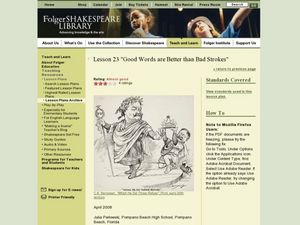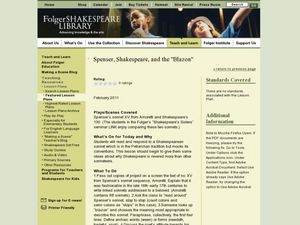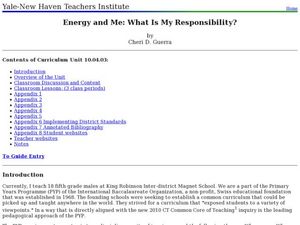Curated OER
Introducing the Ghost: Asking Questions and Finding Answers
Students write words that describe the Ghost in Hamlet and act out scenes to grab the audience's attention. In this Hamlet lesson plan, students use language to interpret feeling and grab the audience's attention.
Curated OER
Sharing the Joy of a Garden
Students see that a garden is a place where an individual can go for inner peace and solitude. They discover that a garden is to be shared. Students describe the importance that a garden has to the environment and lives of individuals...
Curated OER
Smiles Change the World
Students discuss and write about groups that need friends. In this friendship lesson, students create a banner for someone who needs a friend. students pair share to chose a recipient for the banner.
Curated OER
Poseidon's Protectors to the Rescue
Learners explore the concept of philanthropy. In this environmental stewardship lesson, students explore the Greek mythology story of Poseidon. Learners write letters to Poseidon that address water pollution today and express how they...
Curated OER
Valuing the World Around You
Students explore the concept of environmental stewardship. In this character education lesson plan, students examine a quote from John Muir regarding the value of nature.
Curated OER
You Should Not Have Believed Me: Hamlet
Students discuss the sanity of Hamlet and Ophelia in Shakespeare's Hamlet. Students analyze an image from the play to address the sanity of the two characters. Then students read the text to determine whether the characters' words and...
Curated OER
Perception is Not Always Reality
Students view various types of illusions. Using one of the illusions, they try to determine how a scientist might explain them. They discover a t-illusion and use their own words to analyze them. In groups, they research a different...
Curated OER
O how I faint when I of you do write:" Analyzing Shakespearean Sonnets Using "SOAPSTone" and Performance
Students encounter how to use SOAPSTone--a strategy that helps students break down a text to comprehend its intended point of view and audience--in order to analyze Shakespeare's sonnets. They then physicalize their knowledge through a...
Curated OER
The Devilish Tinker Bell!
Twelfth graders examine how cultural context impacts interpretation and that there is more than one correct interpretation of text. Students compare Disney's version of Tinker Bell, from Peter Pan to James I's version of a fairy in...
Curated OER
Good Words are Better than Bad Strokes
Students research negative campaigns and propaganda and then interpret characters from Julius Caesar in that light. In this negative campaign lesson plan, students take the character and create visual images to depict the characters in a...
Curated OER
Spenser, Shakespeare, and the "Blazon": Lesson 4
Students discuss the meaning and tone of Shakespeare's Sonnet 130. In this sonnets instructional activity, students compare Spenser's sonnets to Shakespeare's. Students discuss specific words that add to the humor in Shakespeare's...
Curated OER
"I Banish You": Using Visual and Auditory Imagery to Connect with Speech
High schoolers analyze a monologue by Coriolanus in Shakespeare's play of the same name. In this literature lesson plan, students discuss and define betrayal and the events surrounding Coriolanus' banishment from Rome.
Curated OER
Energy and Me: What is My Responsibility?
Students investigate energy and their impact on the environment. In this environmental lesson plan, students will conduct a series of three activities that will help in their understanding of energy and how we use it.
Curated OER
Romeo and Juliet
Students read Romeo and Juliet and then write an essay from the point of either Lord Capulet or Friar Lawrence persuading someone to adopt their views concerning marriage.
Curated OER
The Merchant of Venice
Students read parts of Shakespeare's play The Merchant of Venice. Using primary sources, they gain a glimpse into the early modern period's negative perceptions and stereotypes of human beings of African descent.
Curated OER
Whatever Happened to Shylock?
High schoolers, in groups, write and perform an unwritten scene from a play they are reading.
Curated OER
OF PASSIONS SUNDRY AND STRANGE
Students examine on-line primary sources to gain an understanding of Elizabethan attitudes toward different character traits. They use these ideas to help explain Lear, or another strong character, more fully.
Curated OER
Get Thee To Wife!
High schoolers read and analyze a piece of literature from 1591 to investigate whether Elizabethan fathers were patriarchal dicatators. Students read the passage and answer questions to determine what fathers were like during the late...
Curated OER
"MONEY FOR SOMETHING:" UNDERSTANDING USURY IN THE MERCHANT OF VENICE
Students learn the concept of usury in The Merchant of Venice.
Curated OER
TO LOVE, HONOR AND OBEY (ONE'S PARENTS!)
Learners examine parent-child tensions regarding obedience and communication, in order to explain the conflicts in the opening scene of King Lear. They discuss ways in which expectations for studenT obedience were different in...
Curated OER
Reader's Theater, King Lear, and the Language of Gesture
Students perform a Reader's Theater of a small section of the play, King Lear. They examine the text, read a handout for Reader's Theater techniques, cut and reorder lines in small groups, and add choreography to perform their scene.
Curated OER
O, LEAR'S MANY REASONS
Students analyze King Lear's speech and identify his "darker purpose", and let them explore different styles for reading it aloud. They can perform the scene as well.
Curated OER
And. . . Freeze!
Learners read a short section of a scene very closely and develop a tableaux as a start to the performance process. They write a paragraph in the voice of a character. They present their beginning, middle and end tableaux to the class.
Curated OER
Macbeth: What's Up with the Crime Scene?
High schoolers are introduced to Macbeth by having them act out the scene where Duncan's murder is discovered. This activity enable students to use dialogue only to discover the structure and format of a scene and explain plot.

























